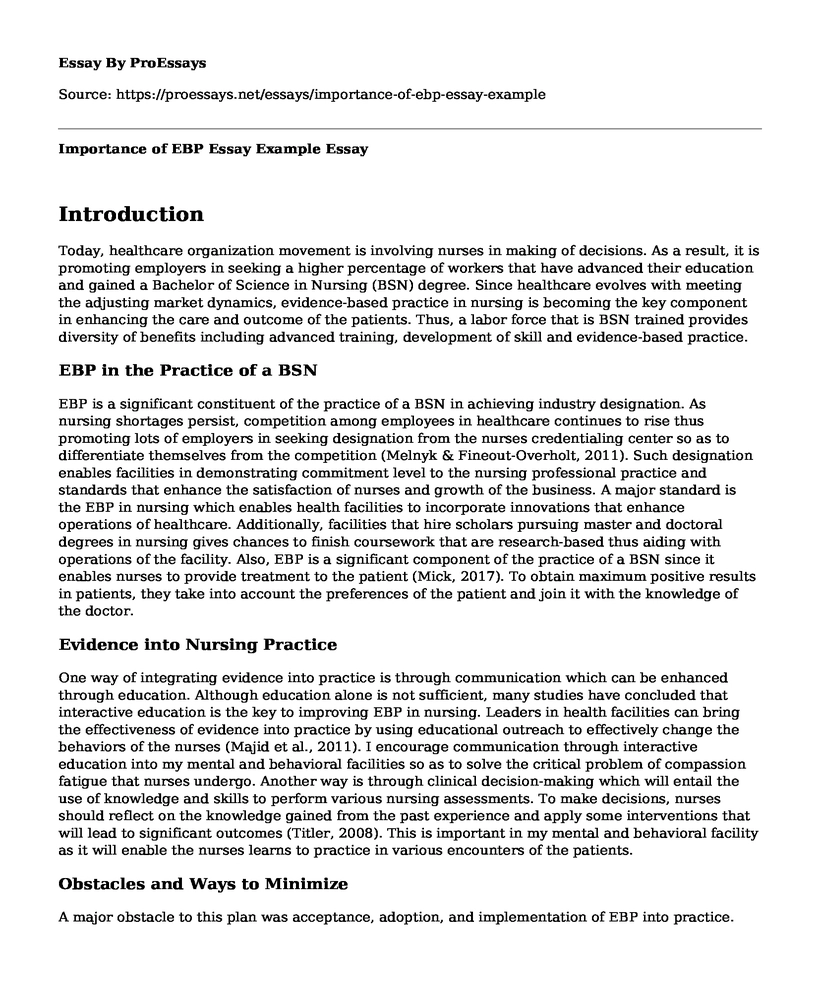Introduction
Today, healthcare organization movement is involving nurses in making of decisions. As a result, it is promoting employers in seeking a higher percentage of workers that have advanced their education and gained a Bachelor of Science in Nursing (BSN) degree. Since healthcare evolves with meeting the adjusting market dynamics, evidence-based practice in nursing is becoming the key component in enhancing the care and outcome of the patients. Thus, a labor force that is BSN trained provides diversity of benefits including advanced training, development of skill and evidence-based practice.
EBP in the Practice of a BSN
EBP is a significant constituent of the practice of a BSN in achieving industry designation. As nursing shortages persist, competition among employees in healthcare continues to rise thus promoting lots of employers in seeking designation from the nurses credentialing center so as to differentiate themselves from the competition (Melnyk & Fineout-Overholt, 2011). Such designation enables facilities in demonstrating commitment level to the nursing professional practice and standards that enhance the satisfaction of nurses and growth of the business. A major standard is the EBP in nursing which enables health facilities to incorporate innovations that enhance operations of healthcare. Additionally, facilities that hire scholars pursuing master and doctoral degrees in nursing gives chances to finish coursework that are research-based thus aiding with operations of the facility. Also, EBP is a significant component of the practice of a BSN since it enables nurses to provide treatment to the patient (Mick, 2017). To obtain maximum positive results in patients, they take into account the preferences of the patient and join it with the knowledge of the doctor.
Evidence into Nursing Practice
One way of integrating evidence into practice is through communication which can be enhanced through education. Although education alone is not sufficient, many studies have concluded that interactive education is the key to improving EBP in nursing. Leaders in health facilities can bring the effectiveness of evidence into practice by using educational outreach to effectively change the behaviors of the nurses (Majid et al., 2011). I encourage communication through interactive education into my mental and behavioral facilities so as to solve the critical problem of compassion fatigue that nurses undergo. Another way is through clinical decision-making which will entail the use of knowledge and skills to perform various nursing assessments. To make decisions, nurses should reflect on the knowledge gained from the past experience and apply some interventions that will lead to significant outcomes (Titler, 2008). This is important in my mental and behavioral facility as it will enable the nurses learns to practice in various encounters of the patients.
Obstacles and Ways to Minimize
A major obstacle to this plan was acceptance, adoption, and implementation of EBP into practice. This can be due to lack of authority among nurses in changing procedures of patient care and insufficient time in implementing the new ideas (Titler, 2008). To solve this, education and training are important since it will show nurses the essence of adopting evidence into practice thus helping to solve some of the underlying problems they may be facing. Another obstacle is poor information technology hence leading to inadequate and delayed communication. Communication is vital in healthcare, and all practitioners should access all information and messages of the facility so as to enhance progress. However, failure to this may interfere with positive outcomes of the facility. To overcome this is to use new standardized and advanced technology that will ensure information is accessed by all practitioners in the health facility.
References
Majid, S., Foo, S., Luyt, B., Zhang, X., Theng, Y. L., Chang, Y. K., & Mokhtar, I. A. (2011, July 17). Adopting evidence-based practice in clinical decision making: nurses' perceptions, knowledge, and barriers. Journal of the Medical Library Association: JMLA, 99(3), 229. https://www.ncbi.nlm.nih.gov/pmc/articles/PMC3133901/
Melnyk, B. M., & Fineout-Overholt, E. (Eds.). (2011, March 6). Evidence-based practice in nursing & healthcare: A guide to best practice. Lippincott Williams & Wilkins.
Mick, J. (2017, April 3). Call to action: How to implement the evidence-based nursing practice. Nursing2018, 47(4), 36-43. https://www.nursingcenter.com/cearticle?an=00152193-201704000-00011&Journal_ID=54016&Issue_ID=4077921
Titler, M. G. (2008, September 15). The evidence for evidence-based practice implementation. https://www.ncbi.nlm.nih.gov/books/NBK2659/
Cite this page
Importance of EBP Essay Example. (2022, Aug 05). Retrieved from https://proessays.net/essays/importance-of-ebp-essay-example
If you are the original author of this essay and no longer wish to have it published on the ProEssays website, please click below to request its removal:
- STI in Teenagers in the State of Hawaii: Impact Evaluation Paper Example
- Assignment Example on HIPAA and the HITECH Act
- Diabetes Type 1 Paper Example
- Research Paper on Nursing Representative in the Ethics Committee
- Essay Sample on AACN: Impact & Importance on Contemporary Nursing
- Obesity: Risk Factors, Complications, & Strategies for Sustainable Prevention - Essay Sample
- Report Example on Patient Using Complementary & Alternative Medicine







